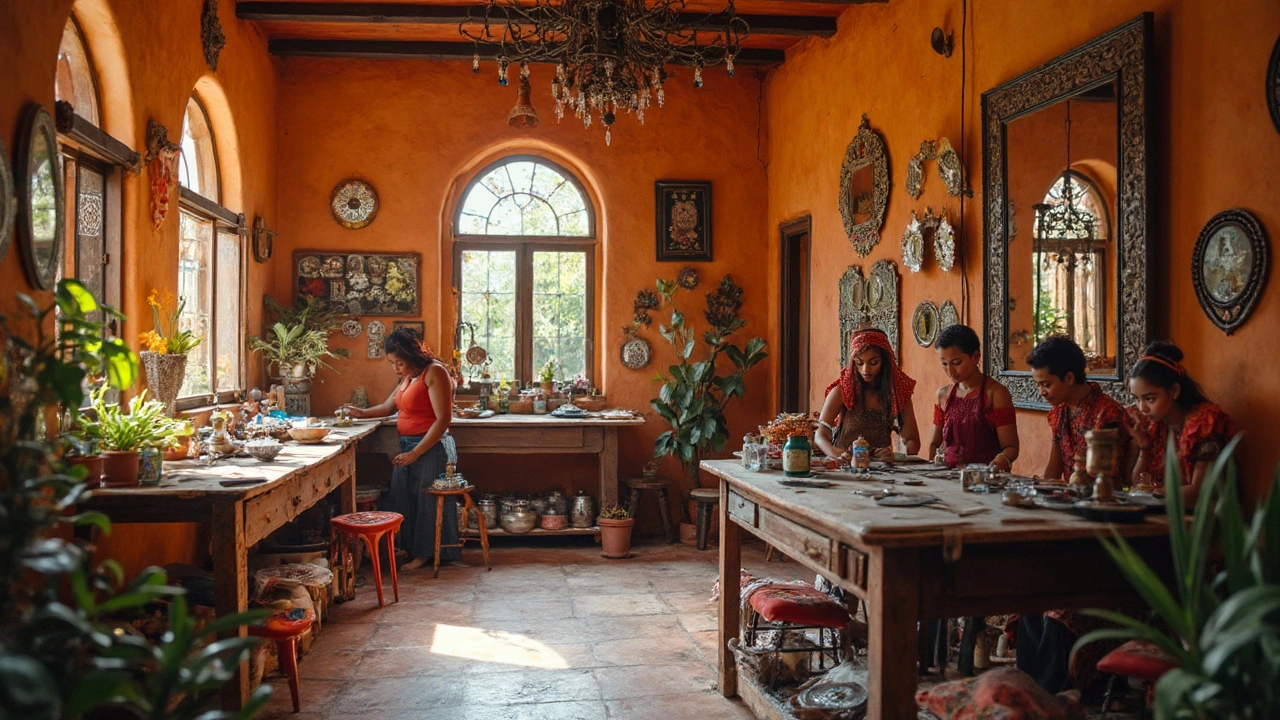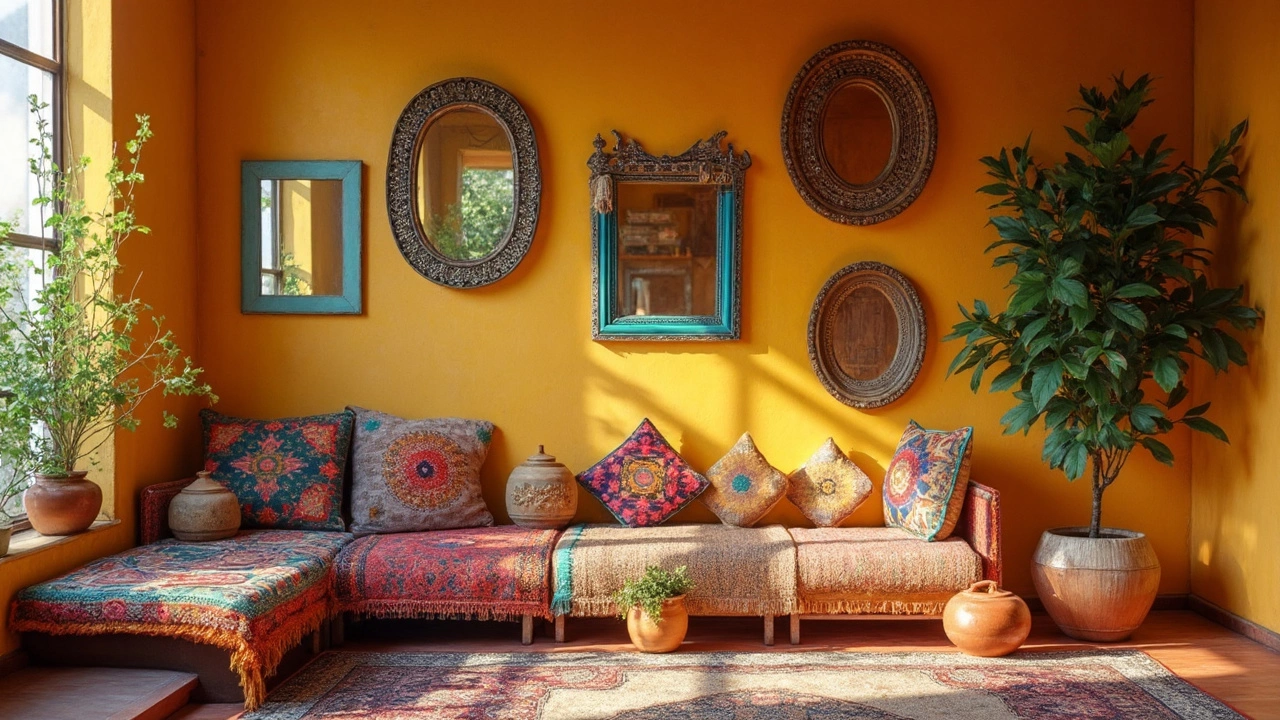Mexican Mirrors: Unique Style, Craft, and Everyday Use

Ever seen a mirror framed by tin, bursting with bright colors and hand-pressed patterns? That’s a Mexican mirror—definitely not your average, plain glass from the big box store. Mexican mirrors are usually made by artisans, with each one looking a little different from the next. They stand out because of all the folk art touches: think sunbursts, flowers, or even funky skulls worked into the frame.
Why do people snap these up? The difference is obvious when you hang one up. My kids—Jax and Eliana—once argued over who got to keep a tiny, pink-framed mirror we brought home from a trip to Mexico. These mirrors become part of your space, not just something you check your hair in.
- What Exactly Are Mexican Mirrors?
- The Craft: Materials and Making Process
- How to Use Mexican Mirrors at Home
- Buying Tips and Care
What Exactly Are Mexican Mirrors?
Mexican mirrors are a totally different vibe from the mirrors most people are used to. First off, these aren’t mass-produced—each one is handmade, usually by skilled artisans who’ve been doing this for generations. The whole point is expression, not just function. People use them for decoration as much as for checking their reflection.
Most Mexican mirrors feature a framed border that’s way more interesting than anything you’d find in a regular home store. You’re likely to see frames made from tin, sometimes called "hojalata," but there are also examples with hand-painted wood or even ceramic. The frames may be pressed, embossed, or carved and then painted in bold colors—reds, blues, yellows, greens—often with folk art themes like flowers, animals, or hearts.
Here are some types of styles you’ll run into most often:
- Tin mirrors (hojalata): These are the classic ones, with shiny, stamped tin borders. Sometimes they’re left silver, other times they’re painted bright colors.
- Talavera ceramic mirrors: These use glazed ceramic tiles around the frame, creating a really colorful and heavy piece.
- Hand-painted wood mirrors: You’ll see a lot of Day of the Dead and floral motifs, painted by hand and sealed for a glossy finish.
What really sets Mexican mirrors apart is the folk art patterns. Sunbursts, skeletons, birds, religious symbols, and all sorts of nature themes pop up because these mirrors are as much about culture as about utility. You'll spot them in Mexican restaurants, cool Airbnbs, and homes looking to add something lively—because a Mexican mirror is almost like hanging a piece of the country’s spirit on your wall.
The Craft: Materials and Making Process
You can spot a Mexican mirror by its flashy frame, often made from pressed tin, also called "hojalata." Artisans in places like Oaxaca, Puebla, and San Miguel de Allende have worked with tin for generations. Tin is cheap, easy to shape, and surprisingly sturdy, which makes it perfect for these detailed frames.
To create a typical artisan mirror, the process kicks off with cutting sheets of tin into pieces for the frame. The artist then puts each piece on a mold or directly on the workbench and hammers out patterns—like flowers, animals, circles, and zigzags—by hand. Every press leaves a mark, so no two mirrors are ever truly identical. After that, the tin is often coated in bright paint or sometimes left shiny, then pieced together like a puzzle to surround a single piece of glass.
The glass itself isn’t anything weird or magical—it’s regular mirror glass, measured and cut to fit the handmade tinwork. Some makers even use old or repurposed glass to keep things sustainable.
Other materials show up too, but tin is king. Sometimes, you’ll find mirrors edged with ceramic tiles, wood, or even tiny bits of colored glass. Mirrors from Jalisco might be finished with talavera tiles, giving off a brighter, chunkier look. In tourist spots, you’ll see all sorts of wild shapes, from hearts to crosses and sunbursts—not just squares or rectangles.
Making one full decorative mirror takes anywhere from a couple of hours to a whole day, depending on the size and detail. Family workshops usually work assembly-line style, with everyone pitching in: one person cuts, another embosses, someone else paints. It keeps prices fair, even with all that work involved.
Check out the difference that handmade work makes. According to a 2022 study from Mexico’s National Institute of Fine Arts, over 70% of metal folk art exported from the country comes from family-run shops using traditional methods—nothing factory-made here.
- Tip: Lighter, pressed-tin frames are easy to hang almost anywhere. Just use a sturdy hook—you don’t need a professional install.
- Painted frames might need gentle dusting now and then, but the color sticks around for years, even in busy hallways or bathrooms.

How to Use Mexican Mirrors at Home
One cool thing about Mexican mirrors is how easy it is to fit them into all kinds of spaces. You don’t need a perfect hacienda-style house; you just need a spot craving color and personality. These mirrors turn any boring wall into something bold, whether you go for a big statement piece or a simple accent.
Here are some practical ideas to use Mexican mirrors in your place:
- Entryway pop: Hang one near your front door. It sets a cheerful vibe for you and anyone dropping by. A tin mirror with bright colors adds instant warmth.
- Gallery wall: Mix different shapes and frame styles with photos or art prints. Folk art details—like hand-hammered tin or painted tiles—help break up the usual grid-style wall, making things way less predictable.
- Bathroom boost: Tired of basic mirrors over the sink? A Mexican mirror can swap plain for playful. Just make sure to choose one that can handle some humidity, or place it outside the splash zone.
- Accent above furniture: Hanging one above a dresser, couch, or mantel brings the eye up and makes the room feel more styled even if you keep everything else simple.
- Layered look: Place a small mirror on a shelf, surrounded by potted plants or books. The reflective surface bounces extra light around, making cramped corners seem brighter and bigger.
If you’re nervous about going over the top, start small. My son Jax has one shaped like a heart above his bed, and my daughter Eliana tucked a mini sunflower-shaped artisan mirror onto her desk. Trust me, when they outgrow stuff, these are the things they keep—no question.
If you like numbers, here’s a tip: a 2023 home survey from a leading U.S. furniture retailer found that 77% of buyers used mirrors as focal points, while 36% picked decorative mirrors to add “character” to rooms. Mexican mirrors nail both. Plus, because they're handcrafted, you know you’re not getting the same cookie-cutter decor as everyone else on the block.
Buying Tips and Care
Picking out Mexican mirrors can be pretty fun, but there are a few things you’ll want to check before you take one home. Not all decorative mirrors are genuine artisan products—some are mass-produced, even if they look hand-crafted. If you want something real, look for small imperfections in the pattern or design. That’s usually the sign of actual handwork, and honestly, it gives each piece its own personality. In places like Oaxaca and San Miguel, you’ll find markets full of these mirrors. If you’re shopping online, check the seller’s info and read reviews. Many trustworthy sites highlight if items come straight from local artists.
When it comes to materials, most Mexican mirrors use tin, sometimes mixed with wood or colored glass. Tin feels light but can bend easily, so press gently if you need to move the frame. Paint or finish might chip, especially on older pieces. If the mirror’s got those little bits of colored glass or stones in the design, check that everything’s tight, and nothing’s rattling around loose.
Wondering about price? Handmade Mexican mirrors can run anywhere from $20 for a small piece to $300 or more for big, detailed ones. Here’s a quick comparison that might help if you’re checking prices:
| Type | Typical Price Range (USD) | Features |
|---|---|---|
| Small Tin Mirror | $20 - $50 | Simple embossing, painted details |
| Medium Tin/Glass Combo | $60 - $150 | Hand-cut glass, painted wood |
| Large Artisan Mirror | $200 - $300+ | Detailed frames, colorful inlays |
To keep your Mexican mirror looking good, dust the frame with a microfiber cloth. for deeper cleaning, a dab of mild soap on a soft cloth works for both tin and glass—just keep water away from painted spots to avoid damage. Never spray cleaner right on the frame. If the tin frame picks up a dent, gently press it back. Loose stones or glass? A dab of clear glue can usually fix that.
One last thing: don’t forget to hang these decorative mirrors where the frame can be seen. The real magic’s in the details, not just what’s reflected inside.